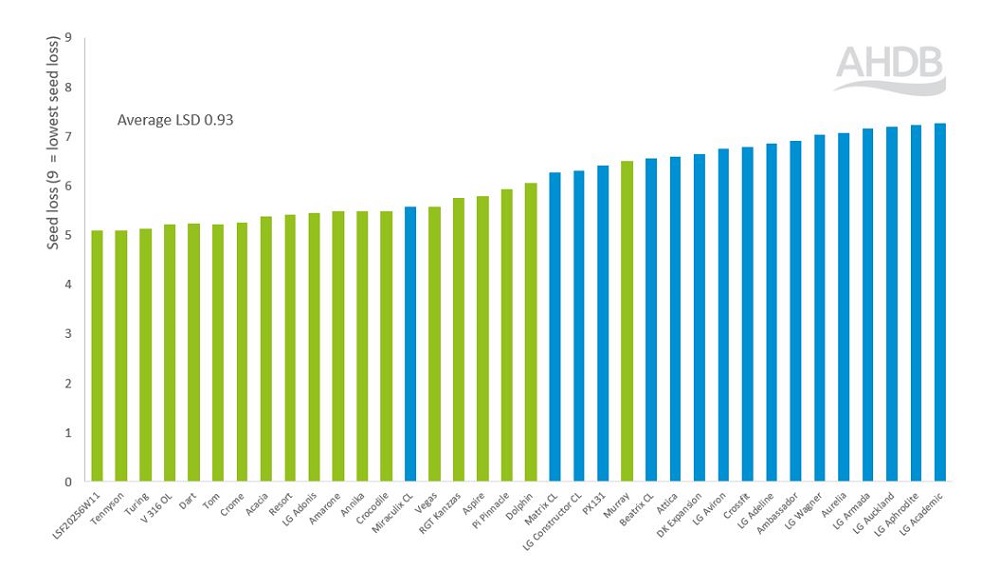Does RL data back up pod shatter resistance claims?
Friday, 9 February 2024
Paul Gosling, who leads the Recommended Lists (RL) at AHDB, reveals what winter oilseed rape trial data can tell us about breeders’ pod shatter resistance claims.
What is pod shatter?
When the pods of many plants ripen, they become dry, brittle and shatter, releasing the seeds of the next generation. It is an efficient and natural solution, but it creates a headache when the seed has a commercial value.
Mature oilseed rape pods are particularly sensitive to pod shatter. Relatively large amounts of seed can shed as the plant ripens, especially when the crop is aggravated by the wind or by the combine at harvest.
Not only does this reduce the amount of crop that makes it safely to the barn, but it also delivers a flush of volunteer oilseed rape plants that need to be dealt with.
Pod shatter resistance
To help farmers identify varieties more likely to retain seeds, we added pod shatter resistance information to the RL 2021/22 edition. It is black and white, with varieties noted as having (R) or not having (-) resistance.
Many hybrid varieties have pod shatter resistance, but the trait does not extend to conventional open-pollinated varieties.
The characteristic is presented as a ‘breeder’s claim’, which is not verified in RL trials. Such claims are usually associated with clear genetic markers (which allow breeders to check if a variety has inherited the trait). For oilseed rape, such traits include:
- Turnip yellows virus resistance (TuYV)
- Tolerance to specific imidazolinone herbicides (a Clearfield® variety)
- Clubroot resistance
Pod shatter resistance is different. It is associated with more than one genetic pathway, making it relatively hard to assess. It also means the trait isn’t black and white, with a range of resistances observed across varieties in trials.
Progress in quantifying the trait has been made in recent years. For example, a random impact test has been developed (partly with AHDB support) that places mature pods in controlled laboratory conditions (specific temperature and humidity) for a few days. Intact pods are then shaken with some steel balls (for a defined frequency and duration) to gauge pod shatter resistance. It is a useful technique and can help identify interesting plant-breeding lines, for example. However, it is not suitable for RL trials, mainly because of the logistics associated with getting samples from RL trial sites to the laboratory in a suitable condition – which we attempted for three seasons.
However, we do record observations of seed loss in the winter oilseed rape yield trials, both prior to harvest and associated with combining. A 1–9 scale is used, where 1 represents severe seed loss and 9 represents no seed loss. This data can be used to add value to the resistance data in the RL.
Harvest 2023
With stormy conditions, harvest 2023 provided a stern test of pod shatter resistance claims. However, observations from a single trial can often mask the truth.
For example, these photos show oilseed rape germinating after harvest of an RL winter oilseed rape trial site in Lincolnshire in 2023.
The two varieties on the left have claims for pod shatter resistance, whereas the two on the right do not.
Pod shatter images
 2.JPG) LSPB
LSPB
At face value, it appears that pod shatter resistance is fairly worthless. However, the site was harvested on a single date, with varieties at slightly different development stages. This may have impacted the results. There may also have been differences in seed dormancy and the presence of oilseed rape in the seedbank at the site.
As usual, it is best to consider several trials to help cut through the site-specific noise.
The chart below is based on an analysis of 11 trials associated with seed loss. Varieties (in trial for harvest 2023) are ordered left to right, with those possessing greater pod shatter resistance shown towards the right-hand side. The varieties with a claim for resistance (blue bars) are generally clustered towards this side. Although the best varieties still lose seeds in a tough year, breeders’ claims broadly stand up to RL scrutiny.
Pod shatter data
 AHDB
AHDB
The data is still quite noisy, with a relatively large least significant difference value (LSD) of 0.93. This means that a variety needs to be more than 0.93 different to another for it to be considered statistically different – a genuine difference that would only occur by chance fewer than 1 in 20 times (5%). This noise means it is not possible to generate a reliable 1–9 resistance rating for the trait in the RL. However, the breeder’s claim information is a good guide.
If you would like more information on any claim, contact the relevant breeder or UK contact. The latest RL booklet (2024/25) includes contact information inside the back cover.
Further information
This article is based on a presentation delivered by Paul Gosling at the 2023 Agronomy Conference on 7 December 2023.
Watch the RL trial presentation from the Agronomy Conference
 1.JPG) LSPB
LSPB


